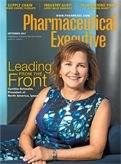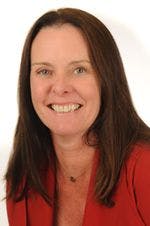Seizing the Opportunity in STEM
Pharmaceutical Executive
How STEM helps women advance from lab bench to boardroom.
It’s so important for girls to find role models and mentors who share their interests in science and technology. If you can’t envision a career involving something you love or are passionate about, you can’t pursue it. To secure vital, powerful and influential C-suite roles, girls need to see examples of women who have done so by leveraging their undergraduate and graduate degrees-and related training-in science, technology, engineering, the arts, and mathematics (STEAM).
I recently had the honor of representing Mylan at the Fifth Annual STEAM Fair and Reception hosted by the Women’s Congressional Policy Institute (WCPI). I was struck by the energy that filled the Rayburn House Office Building in Washington, D.C. that day, which is typically bustling with congressional activity for the US House of Representatives. So many talented girls in middle and high school eagerly and candidly talked about their ambitions and plans to pursue careers in STEAM, or STEM, as the acronym is more widely known (without the reference to “arts”).
Events like these are critical as we try to advance women’s participation in STEM-related fields. According to CEB, women make up about 46% of the labor force in the US, yet only constitute 26% of the STEM workforce. That percentage drops even further the higher you go up the corporate ladder in healthcare and tech companies. This disparity is not surprising, as only roughly 18% of women take STEM courses at the university level, with the remaining 82% opting for non-STEM courses.
Early in my career, I wore a white lab coat and goggles, and spent most of my time at work staring down a microscope. I had no idea what else was possible for someone with my professional background until I was exposed to the business side of science-and that’s where I found my passion.
I can say enthusiastically that STEM jobs shape our world. They’re exciting, critical, influential, dynamic, and never boring. The US Bureau of Labor Statistics closely tracks trends in STEM-related fields and has found that people in STEM occupations, on average, earn higher salaries and higher employment rates than those in who are not in STEM-related jobs. But what is even more exciting for young women is that STEM education and job experience can be leveraged to secure executive leadership roles and positions on corporate boards, where women continue to be vastly underrepresented.
My foundation in science gave me the discipline, problem-solving skills, and intellectual curiosity to pursue a career in the pharmaceutical industry. Growing up in New Jersey, the “nation’s medicine chest,” made a career in STEM not only attainable, but also, desirable. When I look back at my journey from “bench to boardroom,” I now see the inflection points where intervention can be critical for other women. These include advocating for yourself, taking risks, working outside your comfort zone, making personal sacrifices, and most importantly, seeking (and taking) the stretch assignments and special projects that get you noticed by a broad range of people in the company.
In every job that I’ve had in my 30-plus years, I’ve been forthright about my career interests. However, I have noticed that women oftentimes aren’t proactively asking for more -whether it be in the STEM-related fields or positions within corporations-because women typically don’t have the proper role models inside their companies to see what “more” looks like. I’m proud to say that’s not the case at Mylan where I was attracted to our CEO, Heather Bresch, as a kindred spirit in advancing women’s health and making high quality medicine accessible to all people all over the world. At the most bedrock level, this is the ultimate importance of STEM education and careers: to better the world around us.
We must do our part for the next generation of women and show girls the diverse opportunities that exist. We must help girls see a path to securing positions of authority with operational responsibility. We must lead by example and show girls that women direct how research dollars are spent, which innovations to bring to market, how to prioritize and address patient needs, and which resources to deploy in support of specific projects. I am excited to work alongside Heather to increase female talent and leadership at Mylan, and I feel fortunate to work at a company where I am inspired and encouraged every day to dream big, reach higher, and make a difference.

Adele Gulfo is Head of Global Commercial Development at Mylan

Addressing Disparities in Psoriasis Trials: Takeda's Strategies for Inclusivity in Clinical Research
April 14th 2025LaShell Robinson, Head of Global Feasibility and Trial Equity at Takeda, speaks about the company's strategies to engage patients in underrepresented populations in its phase III psoriasis trials.
Beyond the Prescription: Pharma's Role in Digital Health Conversations
April 1st 2025Join us for an insightful conversation with Jennifer Harakal, Head of Regulatory Affairs at Canopy Life Sciences, as we unpack the evolving intersection of social media and healthcare decisions. Discover how pharmaceutical companies can navigate regulatory challenges while meaningfully engaging with consumers in digital spaces. Jennifer shares expert strategies for responsible marketing, working with influencers, and creating educational content that bridges the gap between patients and healthcare providers. A must-listen for pharma marketers looking to build trust and compliance in today's social media landscape.
Pfizer, GSK Gain ACIP Recommendations for RSV and Meningococcal Vaccines
April 18th 2025The Centers for Disease Control and Prevention’s Advisory Committee on Immunization Practices voted to expand access to Pfizer’s respiratory syncytial virus vaccine Abrysvo for high-risk adults in their 50s and voted in favor of GSK’s meningococcal vaccine, Penmenvy, for streamlined adolescent protection.





















